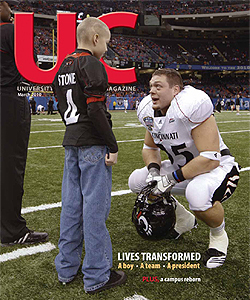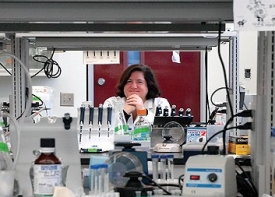University of Cincinnati research under the microscope
When former UC professor Neil Armstrong took his giant leap for mankind, no one realized that the consequence for UC research could include hundreds of millions of dollars one day. A single event, of course, cannot be held responsible for UC's transition into a research powerhouse, yet it plays a key role in a three-fold truth:
The critical period of research growth at universities around the country coincided with the country's quest to reach the moon in the 1960s.
UC has a top 20 ranking in federal research expenditures today.
In 2009 alone, UC received $378 million in research funding.
"When President Kennedy said, 'We're going to go to the moon,' and NASA got involved, that precipitated a lot of push,'' says Frank Tepe, Eng '61, MS (A&S) '63, UC's former interim vice president and university dean for research and advanced studies, who worked in that area from 1973-93. "Universities got more involved in research and the type of research NASA needed.''
As the national research community energized, UC began to consider its own exploration enterprise and, in particular, how students could contribute to its success. That crucial link between research and education, Tepe says, is what has set UC and other universities apart from institutions focused solely on either research or teaching.
Although UC can trace real-world experience for students back to its development of the cooperative education program in 1906, the research-education connection was truly brought into focus in the 1970s, Tepe says. "It goes back to 1973. That was the beginning of an effort at UC recognizing that research was really an integral part of graduate studies.''
That year, research and graduate education offices were combined into one unit, which prompted a shift in thinking. "Graduate students ask good questions,'' he says. "You've got to probe for the answers, and that's what research is really all about.''
Whether or not research growth can be directly attributed to the growth of graduate programs may be up for debate, but the numbers do tell quite a story. Since 1973, graduate enrollment has nearly doubled to more than 8,200, and '09 research dollars were 39 times higher than the "organized research total'' of $9.7 million in 1973.
"Without a doubt, I don't think research has a place in the university without graduate students,'' Tepe says. But there's more to it than that, he adds.
At about the same time that graduate education became a focus, individualized labs and programs were becoming more interdisciplinary in their approach to research. Hence, collaborations across colleges and UC's campuses were increasing.
In addition, support in the form of University Research Council grants helped faculty gather initial data needed to apply for external funding. Today the council distributes more than $700,000 annually, with its largest grants awarded to interdisciplinary research programs.
"Problems cross lines,'' Tepe says. "Physics experts interact with chemists who interact with biologists, who interact with engineers and physiologists. That's the way you solve problems nowadays. In the real world, that's the way industry does it.''
Five years ago, the university incorporated a primary focus on research into its strategic plan. "That really just put into writing what we knew needed to be done in terms of research,'' says Sandra Degen, vice president for research. "It certainly re-energized us, but research has long been a focus of the university.''
In the 1850s, for instance, faculty member Alexander Latta invented the first steam-powered fire engine. Then in the 1920s, General Motors approached a young UC scientist named Robert Kehoe, A&S '18, HonDoc '78, who began lead studies on UC's medical campus, which spurred the development of anti-knock gasoline.
In 1938, UC cancer researcher and pharmacologist E.W. Wallace was among the country's first 10 awardees from the National Institutes of Health (NIH), which became a major supplier of university research funding.
The next decade, UC researcher George Rieveschl, A&S '37, MS (A&S) '39, PhD (A&S) '40, HonDoc '56, developed Benadryl, the world's first effective antihistamine. Next, the famed Albert Sabin, HonDoc '74, developed the first live-virus polio vaccine in the late 1950s while working at UC and Cincinnati Children's Hospital Medical Center.
At present, nearly half of UC's total funding comes from the NIH with the majority of those dollars supporting UC's medical college. Tracking how those research dollars are spent helps the university know where it stands.
"Research expenditure data are great indicators of the amount of research activity happening on campus,'' says Degen. And federal data is "truly an apples to apples comparison to other universities.''
To help draw those comparisons, the National Science Foundation reports on expenditures for universities across the country each year. In 2007 (data lag about two years behind), UC was ranked among the top 25 for total research expenditures among public universities. In isolating federal expenditures alone, the university jumped to the top 20.
Achieving that required years of steady growth in funding, as well as improved research infrastructure, graduate-student involvement, interdisciplinary approaches and representation on national and state research boards. The next steps are likely to concentrate on translation, community engagement and even earlier student involvement.
Already, undergraduate students are becoming increasingly present in campus laboratories and research settings. Plus, a current $23 million NIH grant contains a community-engagement component to improve community-based research at local agencies.
Ultimately, UC researchers are working diligently to bring innovations from the proverbial lab bench to the people who benefit from discovery. And those discoveries are broad in scope — from treatments for a common disease to improved hospital gowns and tray tables.
"UC has seen tremendous growth in research activity,'' says Degen. "But the way I see it, we're still just getting started. There are so many great things to come.''
Link:
Read the latest UC research news

 Issue Archive
Issue Archive